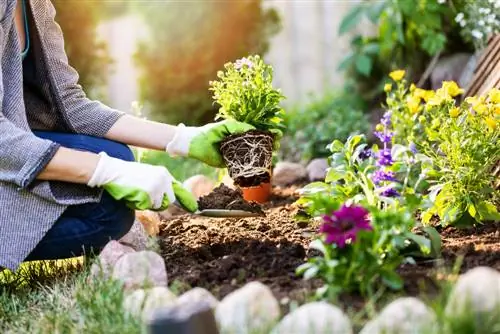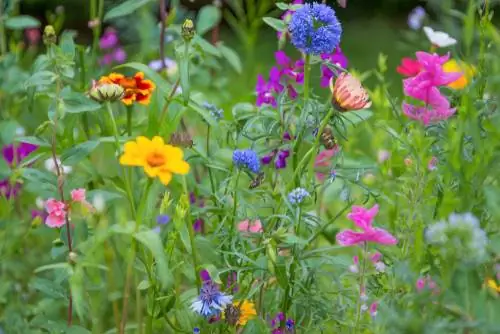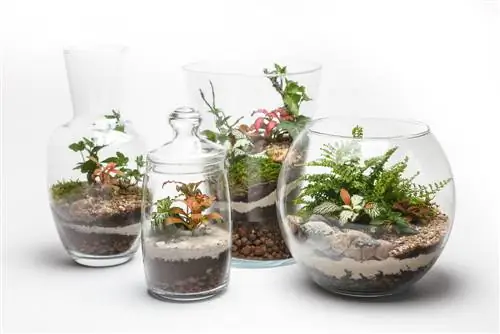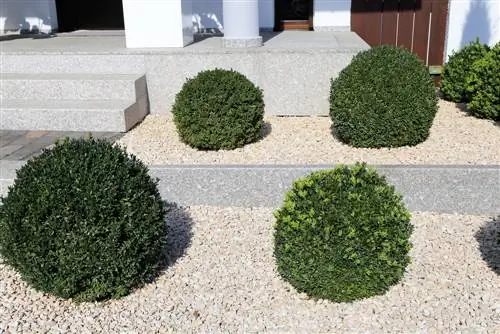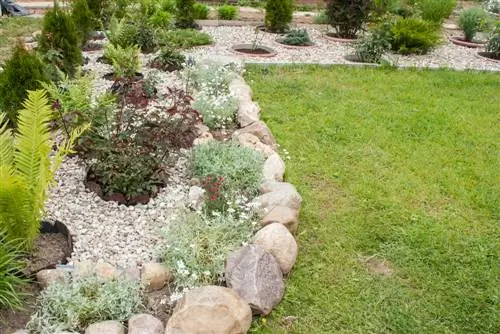- Author admin [email protected].
- Public 2023-12-16 16:46.
- Last modified 2025-06-01 06:02.
The planting plan is a first milestone on the way to a lavish flower bed. Important basic criteria and an imaginative plant composition pave the way for beginners to a flower paradise straight out of a glossy magazine. Get inspired here by ideas and tips on how to create a picturesque flower bed in a playful and easy way. This is how it works without weeds and without digging.
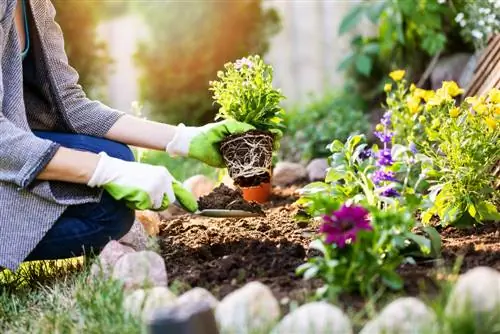
How to create a flower bed?
You can create a flower bed with a planting plan. The basic criteria include filling perennials, tall leading perennials and low accompanying perennials. Mulch and weed fleece counteracts weed growth. Create a curved, round or square shape. If you plant hardy flowers, the bed will bloom all year round.
Creating a flower bed - ideas for the planting plan
The flower bed becomes a gem in the garden if you record the local conditions at the location in advance in a plan sketch. Note the lighting conditions and soil conditions, as the right choice of plants depends on this. So that the finished flower bed is perfectly embedded in the overall look of the garden, determine the shape. The images below demonstrate a variety of options for beautiful lines. The next step is to dedicate yourself to the planting plan. Let the following ideas and basic criteria guide you so that you can correctly create the flower bed you dream of:
- Leading perennials as a framework: as a backdrop and center, tall perennials, such as hollyhock, delphinium, flame flower, peony
- Companion perennials: half-height flowers, such as cockade flowers, coneflowers, lupins, scabiosis, bulbous flowers
- Filling perennials: low gap fillers, such as cranesbill, lavender, girl's eye, annual flowers (snapdragons, mallow, zinnia)
- Division: 10-15% lead perennials, 30-40% companion plants, 50-60% filler perennials
Majestic leading perennials stand out impressively as solitary plants. Companion and filler perennials appear better in small groups. The larger the bed area, the more numerous a type of flower can be represented as tuff. The edge of the bed is reserved for low and compact perennials that reveal the impressive main characters in the background or center. Prime examples are long-blooming cushion flowers, such as blue cushions, cushion phlox or the picturesque candytuft.
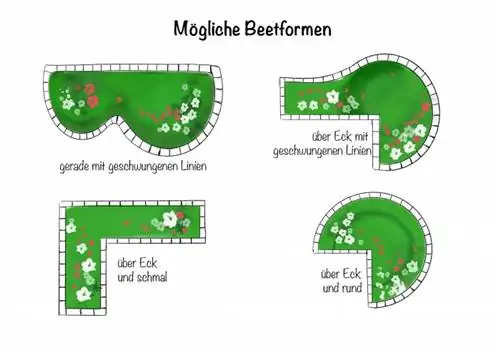
Creating a flower bed - planting plan for beginners
The following planting plan promises the gardening novice love at first sight. The focus is on a plant community that thrives in a sunny location that is easy to care for. The shopping list and arrangement are tailored to a round flower bed with an area of 5 m² and a circumference of around 10 m. With stones as a bed border, the flower arrangement is perfect for a place in the lawn. Special advantage for beginners: all plants are hardy and appear again after winter as if by magic:
Shopping list:
- 2 pieces of torch lily (Kniphofia uvaria) in orange-red
- 1 piece mountain Illex (Illex crenata)
- 7 pieces of cockade flower (Gaillardia grandiflora)
- 9 pieces of garden coneflower (Echinacea purpurea 'Cheyenne Spirit)
- 47 pieces of red houseleek (Sempervivum Hybride)
- 16 pieces of blood-red cranesbill (Geranium sanguineum)
Instructions for plant arrangement
The two torch lilies act as leading perennials, taking up positions on the right and left in the background. Evergreen mountain Illex takes place in the middle of the bed. Cockade flowers and coneflowers are intended to serve as companion perennials, which makes spatial proximity to the torch lilies useful. At the edge of the bed, houseleeks show off their dark red colors. Where there are still gaps, the planting plan calls for blood-red cranesbills, ideally in small groups.

Create a flower bed without weeds - this is how it works
Under the weight of rampant weeds, freshly planted flowers lose their courage to live. It doesn't have to come to this if you create a flower bed without weeds. If you integrate effective weed protection into your planting plan, you will be spared the hassle of weeding, which will more than halve the maintenance effort. The following instructions explain step by step how to do it correctly:
- Rake the bed area thoroughly, weed and clean of roots and stones
- Distribute compost soil and bury it under the garden soil
- Smoothing the soil with a rake
- Lay weed fleece and protect against slipping with ground anchors
- Place plants on the fleece according to the planting plan
- cut the fleece in a cross shape for each plant with a knife
- soak the potted plant in water, unpot it, place it in the ground and water it
- Place fleece corners as close as possible to the root neck
Finally, take the weed fleece out of your field of vision. This can be done cheaply and decoratively with gravel, wood chips or bark mulch. If you use fleece with a thickness of more than 90 g/m², weeds have no chance of breaking through.
Excursus
Create a flowerbed without digging
Sweaty digging is not a requirement when you create a new flower bed. Create a fence around the intended area using stones, small wooden palisades or slats. Then line the area with unprinted cardboard without staples. Please ensure that the edges overlap by at least 10 centimeters. Now fill the cardboard area with 10 to 15 centimeters of sifted garden soil and let everything settle for a week. In the last step, apply a 10 to 15 centimeter high layer of compost soil. It's that easy to create a flower bed without digging.
Flower collection - inspiration for every location
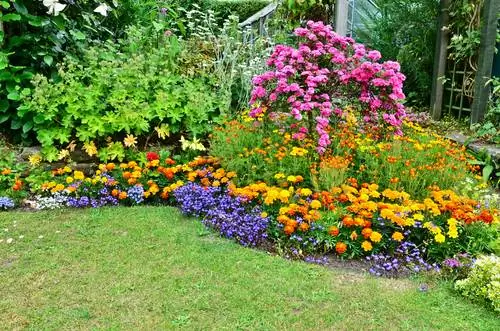
When combining, pay attention to the height of the flowers
Floral bed compositions always become a successful project when flowers, perennials and grasses are given the right location. Please always take local lighting conditions into account when selecting plants when creating a flower bed. This premise in no way limits the choices. As the following flower collection shows, you can choose from the full range of magnificently blooming flower species for all locations:
| Sunny south side | Flowering time | Penumbra | Flowering time | Shadow north side | Flowering time |
|---|---|---|---|---|---|
| Coneflower (Rudbeckia fulgida) | August to October | Foxglove (Digitalis) | June to August | Epimedium diphyllum | April and May |
| Storksbill (Geranium) | June to October | Columbine (Aquilegia vulgaris) | April to July | Liverwort (Hepatica nobilis) | February to April |
| Lavender (Lavendula) | June to September | Astilbe | August to October | Funkie (Hosta) | June to September |
| Girl's eye (Coreopsis grandiflora) | June to August | Tall phlox (Phlox paniculata) | July to September | St. John's wort (Hypericum androsaemum) | July to October |
| Cockade flower (Gaillardia x grandiflora) | July to September | bleeding heart (Dicentra spectabilis) | May to July | Nettle king (Lamium orvala) | May to July |
| Delphinium (Delphinium) | June to October | Fuchsia (Fuchsia) | July to October | Wood anemone (anemone) | March to May |
| Hollyhock (Alcea rosea) | July to September | Purple bells (Heuchera) | June to September | Fern Larkspur (Corydalis cheilanthifolia) | April to June |
| Magnificent candle (Gaura lindheimerii) | May to October | Bluebells (Mertensia virginica) | April and May | Mountain Forest Cranesbill (Geranium nodosum) | August to November |
| Sun Bride (Helenium x cultorum) | June to August | Pre-summer phlox (Phlox idahonis) | May to July | Memorial (Omphalodes) | March to May |
| Flame Flower (Phlox) | June to August | Rose primrose (Primula rosea) | March to May | Dog rose (Rosa canina) | June to October |
| Roses (Pink) | June to November | Hydrangea (Hydrangea) | June to September | Christmas rose (Helleborus) | November to February |
The multi-faceted collection is rounded off with onion flowers for a colorful start to blooms in early spring. Snowdrops, marshmallows and crocuses act as a neat vanguard before the big flower spectacle gets underway in mid-May.
Flower bed for bees - simple flowers have priority
Please give preference to flowers with simple flowers when creating a flower bed for bees with children. They are unfilled flower shells that create a stage in the bed for the big hum and hum. Lush double flowers, on the other hand, are a disappointing deception for bees, bumblebees and butterflies.
Bed design with flowers and grasses - planting plan
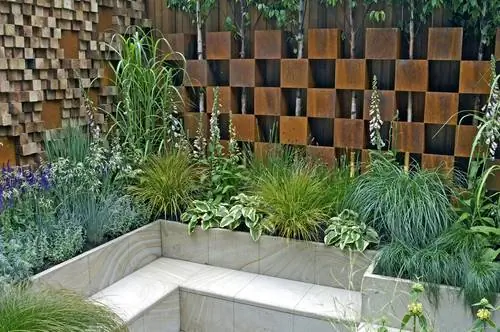
Foxglove can be combined well with grasses
Flowers like to have a decorative dialogue with delicate grasses. In the middle of the lawn or along the house wall, the dream team of flowers and ornamental grasses transforms mundane green areas and house walls into poetic eye-catchers. The following planting plan will inspire your imagination for a successful bed design with perennials and grasses. The plan is suitable for sun and partial shade as well as a bed area of 8.5 m² with white marble gravel as flooring. The focus is on easy-care and hardy plants.
Shopping list
- 2 pieces of foxglove (Digitalis purpurrea)
- 2 pieces of miscanthus 'Hermann Müssel' (Miscanthus sinensis)
- 6 pieces of garden sedge 'Everlime' (Carex oshimensis)
- 6 pieces of purple bells white (Heuchera hybrid)
- 34 bag of marble gravel 'Carrara' white, 40-60 mm grain size, 15 kg per bag
Note for families: If you create the flower bed with children, please replace poisonous foxglove. Safe alternatives are hollyhocks, sunflowers or sunflowers.
Instructions for plant arrangement
In the flower bed with grasses, an aura of subtle elegance is created if you don't place the plants too close together. Foxglove or a non-toxic alternative dominates in the background on the right and left. Miscanthus keeps enough distance from the flowering main perennials so that garden sedges can settle in the gaps as companion plants. Three small tuffs, each with two purple bells, provide some relaxation. Impressive contrasts are created when you choose white marble gravel as your floor covering.
Show your creative courage for the morbid beauty of planted ornamental grasses. In autumn, tie the dead clumps together with colorful jute ribbons. When winter frost causes grasses and ears of corn to glitter in the sun or a snowcap perches on seed heads, the lack of flowers is easy to get over.
Flower beds are poems that gardeners write on the garden floor.
Ideas for a perennial flower bed
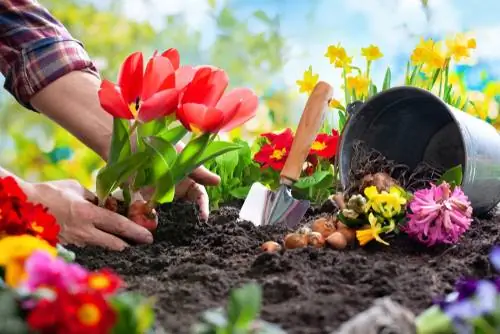
Spring is the time for flower bulbs
A flower bed all year round in Sunday dress is a long-cherished wish for many hobby gardeners. In order for the plan to succeed, it is important to have a hardy plant combination that does not reveal everything at once. For each season, choose one or two flowering protagonists that will delight you with decorative leaves for the rest of the year. This collection of ideas should serve as an example and instructions for a perennial flower bed:
- Spring Flower bulbs open the flower dance: snowdrops, daffodils, marshmallows and tulips
- Summer Leading perennials with a long flowering period: phlox, sun bride, rose mallow, scabiosis, steppe sage
- Autumn Flowers until the first frost: winter aster, phlox, goldenrod, autumn monkshood, roses
- Winter Decorative foliage plants and winter bloomers: hosta, snow rose, purple bells
In the perennial flower bed, compact flowering bushes take on the role of scaffolding. The trees chosen should not steal the show from the flowers, but rather complement them harmoniously. Snow forsythia (Abeliophyllum distichum), dwarf almond (Prunus tenella) start in spring. Buddleia (Buddleja davidii) and weigela (Weigelia) decorate the flower bed in summer and pass the floral scepter on to opulent hydrangeas (Hydrangea) in autumn. In winter, winter snowball (viburnum) sets picturesque accents.
Tip
If there is a liaison of flowers and vegetables in the planting plan, you will give your flower bed a cottage garden flair. Climbing peas boast purple butterfly flowers. The historic broad bean variety 'Crimson Flowered' impresses with its ruby-red flowers. Distinctive umbel flowers decorate parsley and carrots.
Design a Mediterranean flower bed - tips for the planting plan
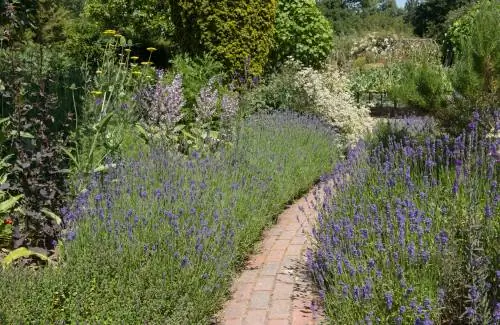
Lavender should not be missing in the Mediterranean flower bed
A flower bed will shine Mediterranean if you note southern flowers, perennials, herbs and trees in the planting plan. Authentic plants from the Mediterranean thrive as sun worshipers and prefer predominantly dry and nutrient-poor soil. Under these conditions, the following plants are perfect for a Mediterranean flower bed in the sunny rock garden on the south side:
- True lavender (Lavandula angustifolia)
- Sunflower (Helianthemum)
- Fuchsia (Fuchsia papagena)
- Jewelry basket (Cosmos bipinnatus)
- Sage (Salvia nemorosa)
- Oregano (Origanum vulgare)
- Mediterranean snowball (Viburnum tinus)
- Cotoneaster ‘Red Robin’ (Photinia fraseri)
Give a Mediterranean flower bed the finishing touches with matching accessories. If you place the bed on the house in front of a house wall, wall fountains and colorful terracotta mosaics create a southern ambience. Plant some flowers and herbs in hand-painted terracotta pots that you place in the middle of the flower bed as stylish accessories.
Flower bed on the balcony - ideas for balcony boxes
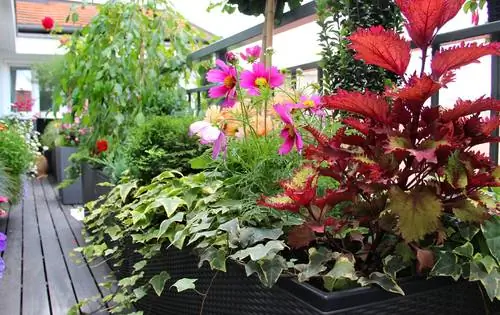
With the right choice of plants, the balcony becomes a balcony garden
The flower box on the balcony is the territory of annual magnificent flowers. The exposed position encourages a planting plan that draws on the full potential. On the south side, hanging petunias 'New Celebration' and tricolor morning glories 'Ensign Mixture' transform the balcony into a summer fairytale with casually dangling cascades of flowers. Colorful dwarf snapdragons or bright blue male faithful rise standing and in the gaps.
In the balcony box on the north side, sun abstainers present themselves with a floral presence. Noble lilies, begonias, coleus and hostas transform the low-light location into an enchanted flower bed. Shade-tolerant ornamental grasses imaginatively round off the planting plan, such as white grove ledges or easy-care shade sedges.
When is the best time of year?
The time window opens twice a year to create a flower bed in the garden. In spring, the planting season begins in mid-May, when the worst danger of ground frost has passed after the Ice Saints. Autumn is the ideal time for perennials and trees to take root in the garden soil.
Balcony gardeners plant a flower bed in a box preferably in spring from the end of April/beginning of May. By the time the beautiful season is in full swing, flowers, perennials and flowering vegetables have revealed their full splendor.
Frequently asked questions
We are planning to create a flower bed on a hillside. What should you pay particular attention to?
The most important measure is stable slope protection. The degree of gradient determines the choice of means. A dry stone wall made of natural stone is recommended. In order to make the flower bed on the slope modern, gabions with stone filling come into focus. Wooden palisades and old railway sleepers exude a historical cottage garden flair. For the planting plan, please note primarily deep-rooted plants that additionally stabilize the soil. On the southern slope, floribunda roses, bergenias and grasses are a good choice.
What stylistic means can I use to create a modern flower bed?
High priests of modern garden design advocate clean lines, geometric shapes, natural materials and tasteful accessories to create a contemporary flower bed. A narrow, rectangular or round bed border made of natural stone marks the starting point. Gravel or bark mulch cover the ground. Solar balls and spotlights add modern accents. Trendy flowers and trees are the main stars, such as ball hydrangeas 'Annabelle' or bearskin fescue 'Pic Carlit'.
We are planning to create a colorful mixed flower bed in the garden. Which soil should we use?
The best substrate for flowers, perennials and trees is loose, permeable, rich in humus and nutrients. A mix of compost soil and sand in a ratio of 3:1 is welcome for most plants. If it is a Mediterranean flower bed with lavender, flowering sage and other sun worshipers, increase the amount of sand. If the flower bed decorates the rock garden, mix small-grain gravel into the soil to optimize permeability and reduce nutrient content.
Tip
The online bed planner from Obi provides excellent assistance with creative planting plans. You choose your favorite from a wide range of imaginative design options. Upon request, Obi will send you a planting plan, shopping list with costs and planting instructions free of charge by email. As a beginner, you can easily create your own flower bed cheaply and comprehensibly.

